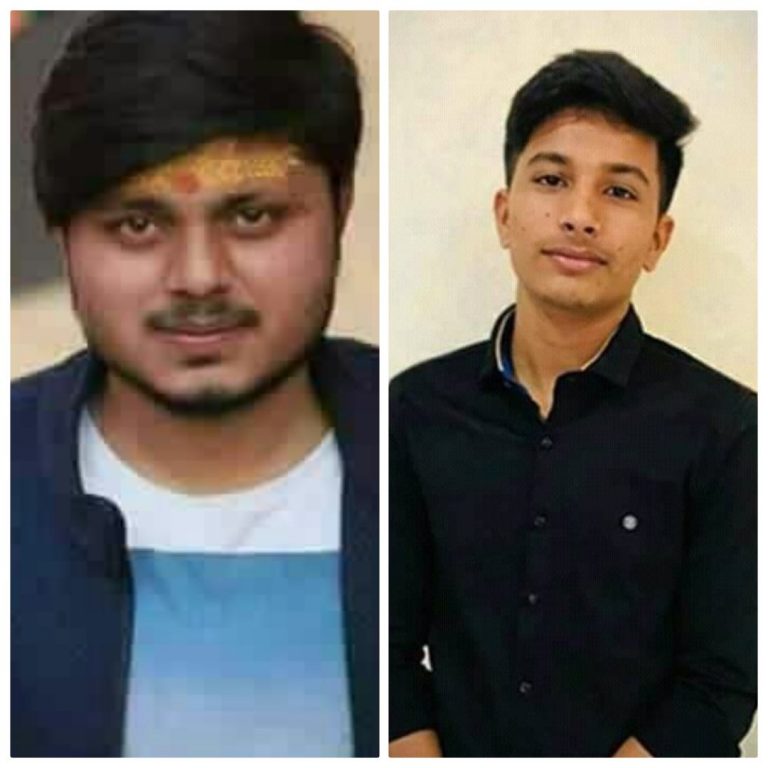Fake news threatens not just democracy but lives in India
At 8 30 a.m. on 27 January 2018, Rahul Upadhyay was having his morning tea on the outskirts of Kasganj, in northern India. He then received a phone call telling him that he was dead.
‘It was a friend of mine and he was saying that messages about my death had been circulating on social media since the previous day. I thought he was joking, but he sounded very serious.’ Upadhyay asked his friend to forward these posts to him on WhatsApp. All of them carried a photograph lifted from his Facebook page in which a marigold garland hung from his neck – the flowers were a symbol that marked him as dead as any other long-departed ancestor. What panicked him were the comments:
‘Rahul Upadhyay martyr’
‘one more life lost to jihadis’
‘blood for blood’
By 10 a.m., Upadhyay was convinced something terrible was going to happen if he didn’t immediately prove to the world that he was living. He tried logging onto his Facebook account, but his phone was no longer connected to the internet. He called up another friend and learnt that they were cut off too. The fury over the ‘news’ of his death had spread so quickly that the local administration had taken emergency action, and cut off all access to the internet in the city.
*
At 10 a.m. on 27 January, Kasganj was burning. The public buses were the first to be set on fire. Even without the internet, the rumours of religious violence had done their work. Most of them about Upadhyay’s death. Thousands of people were convinced that he had been killed by a bullet fired by a Muslim on the previous day, Republic Day, which marks the anniversary of the adoption of India’s Constitution in 1950. Kasganj, like many other towns across India, commemorates it every year. But the 2018 edition of Republic Day was going to be special.
In March 2017, the Hindu-nationalist Bharatiya Janata Party had seized power in the state of Uttar Pradesh after 26 years of defeats and coalitions with political parties they accused of ‘appeasing’ Muslims. Relations between the Hindus and Muslims of Kasganj had been tense ever since. Many Hindus wanted to assert their new status in the city; Muslims intended to defend their rights. Both sides chose Republic Day as the time to stake out their positions.
At 9 a.m. on 26 January, a large group of Hindu boys arrived in a public park for their Republic Day rally, riding motorbikes and carrying flags – India’s tricolour and Hinduism’s saffron. In the ‘enemy’ neighbourhood they wanted to drive through, Muslim boys had finished decorating the thoroughfare for their Republic Day celebration: rangoli, chairs, balloons and a flagpole holding up the tricolour.
Just over an hour later, Kasganj was on the brink of war. The Hindu motorcycle parade had charged into the narrow lane that traversed the Muslim-majority neighbourhood of Baddu Nagar. Muslim boys flooded the streets and blocked their way. The Hindus had demanded passage; the Muslims had refused to back off. The Hindus later claimed the Muslims had shouted slogans of ‘long live Pakistan’; the Baddu Nagar residents claimed the Hindus were chanting ‘say ‘Vande Mataram’ (‘Praise to Mother India’) if you wish to live in India’. At some point, the Hindu men realised they were losing the verbal and physical confrontation; they left their motorbikes behind and ran away, only to return for their revenge in forty-five minutes – which they exacted in another Muslim-majority neighbourhood, Tehsil Nagar. Residents later claimed the Hindus had charged in carrying guns and revolvers; the Hindus claimed the Muslims were waiting for them on rooftops waving guns and revolvers.
The two sides faced off; someone in the crowd opened fire and a bullet hit a 22-year-old Hindu man called Chandan Gupta. Gupta died immediately. In seconds, photos of him, digitally framed and garlanded with marigolds, were circulating through Kasganj via Facebook and WhatsApp. Local Hindus were calling him a martyr and calling out for revenge. By the afternoon of 26 January, another photo went viral. This one announced the murder of ‘another of our boys’ by ‘Muslim mobs’ and demanded Hindu blood boil. The face of the murdered man was Rahul Upadhyay’s. Hindu mobs formed and rampaged through the city, attacking Muslims and destroying their property.

Among the photos of Rahul Upadhyay placed alongside Chandan Ghupta’s (left) that went viral, spreading the rumours of his death, one didn’t even feature his face but that of a man who had died in a road accident in Mumbai on the same day (right).
Rahul Upadhyay never even left his home on Republic Day. The twenty-four-year-old journalist spent the day in his house on the outskirts of town, hoping to file a regular Republic Day report based on press releases. ‘I have never attended a protest or a rally in my life,’ he later told me. The internet shutdown in Kasganj continued over the next two days, and without it he didn’t know how to respond to the rumours of his death, which had continued to spread. They had already crossed the official boundaries of the district through WhatsApp to areas which still had access to the web, and from there the fake news continued to travel far and fast.
‘My family received nearly 400 phone calls in those two days asking about my death and offering condolences. Imagine the pain of parents being consoled about the death of a son who was sitting in front of them!’
As the family confirmed the fact of his ‘good health’ on one phone call after another, news channels flashed live coverage of the outrage over his death. In Gorakhpur, posters of his garlanded photo were being pasted on walls. In Agra, a candle march was organised in his name. In Bareilly, a prayer meeting was held. People in places as far away as Delhi and Mumbai swore revenge in his name.
‘I was feeling sad and scared. People were using my name to provoke violence,’ Upadhyay said. He had no idea why he had been chosen to be the face of this anti-Muslim campaign. ‘I suppose as a local journalist I am a known name,’ he speculated. Some of the WhatsApp posts mourning his death didn’t even carry a photo of him. Instead, they included photographs of a man who had actually died on Republic Day – though he’d died in a road accident in Mumbai, more than a thousand kilometres away. Things were turning truly bizarre. Rahul Upadhyay decided he should drive into town to show people he was alive, but by this time the district administration, panicking about the ongoing violence, had shut down the roads as well.
By the morning of 29 January, when the curfew was lifted and the internet was back on, the Muslim areas of Kasganj looked like disaster sites. First the houses had been destroyed, then the shops, and finally the mosques. Hundreds of people had been injured. At 10 a.m., Rahul Upadhyay showed up at the police station, presented himself to the deputy inspector general, and made the most noteworthy statement of his life: ‘I am Rahul Upadhyay and I am not dead.’
At a press conference called by the district administration, Upadhyay, a tall, lean man dressed in a striped shirt and a sweater vest, stood stiff and unsmiling as he was asked again to confirm that he was indeed alive. Speaking into the mikes, he repeated two lines from what had become his favourite ghazal, ‘There had been a rumour about my poor health / but it is endless questions from people that made me actually ill.’
Later that day, the town’s police announced that they had arrested four people for spreading rumours over social media. One had been arrested for being the admin of a WhatsApp group that had sent out provocative posts, and the others for circulating it. A hunt was launched to ‘nab’ other people guilty of forwarding rumours.
*
These four aren’t the first culprits to be arrested for spreading rumours through social media. In May 2017, two people were arrested in rural Jharkhand for spreading rumours that led to the lynching of seven people. The posts were generated on Facebook and circulated over WhatsApp; the murderous crowds later explained to the police that the posts looked too ‘real’ not to respond to.
The messages, sent to parents in remote areas dominated by tribal communities, claimed that outsiders were kidnapping kids from schools in order to sell off their body parts. Hundreds of children go missing in Jharkhand, a hub for human trafficking, every year. Every tip, real or fake, provokes paranoia. These posts had photographs of dead children as well as various objects – syringes and handkerchiefs – purportedly used in the kidnappings. The text, written in Hindi, read: ‘Suspected child lifters are carrying sedatives, injections, spray, cotton and small towels. They speak Hindi, Bangla and Malayalam.’ Parents were told to watch out for the movement of suspicious-looking people in their neighbourhoods, especially people who dressed in black and spoke a mysterious language. None of the people who were beaten to death on the suspicion of being child lifters wore black. Four of them were Bangla-speaking Muslims who were driving through the area with cattle they intended to sell back home, in the neighbouring state of West Bengal. Ten days after these attacks, two people were arrested for starting the rumors – a businessman for creating the post on Facebook and a journalist for releasing it into local WhatsApp groups. Their motives remain unknown.
There was nothing vague about the target of the next rumour that went viral in Jharkhand. One morning in June 2017, someone in the Ramgarh district sent out a WhatsApp message saying that a local Muslim trader was driving out of town carrying beef in his car. It was forwarded hundreds of times within an hour, and soon a mob surrounded his vehicle, dragged him out, bludgeoned him to death, and set the car on fire. Two days later, the town’s police arrested the local representative of the Bharatiya Janata Party for ‘instigating the mob’. This wasn’t the first time an Indian politician has egged on a mob in the name of religion, but now they no longer have to gather a crowd and make a speech to incite that hatred. One click is all it takes.
*
In March 2018, large-scale Hindu-Muslim riots broke out in Bihar after a Hindu procession passing through a Muslim area was hit by a slipper. Following a pattern set over the past few years, hateful messages calling on Hindus for an urgent reprisal showed up on WhatsApp groups in Samastipur, where the incident took place, and shot through the state in a matter of hours. Blazing through Bihar for a whole fortnight, the violence burnt down thirty-eight districts and left hundreds wounded. Among the 200 people arrested were two leaders of the BJP who had ‘disturbed communal harmony’.
In a society as divided as India – which segments according to caste, class, religion, region and language – clashes have always been common. And they have often started with rumours. But these are no longer circulating through tea shops and fish markets. Instead, they are regularly going viral on WhatsApp, the Facebook-owned instant messaging service. The speed with which communities can now respond to these rumours has left officials at a loss, and challenge the very existence of India’s many minority groups. Of the country’s 300 million smartphone users, 200 million use WhatsApp, making India the messaging platform’s biggest market.
It is easy to see why WhatsApp is India’s favourite social network. It is free. It is easy to use – you don’t have to sign up or log in. The app consumes less data than Facebook or Twitter. And it allows you to send a private message to 256 people at the same time, a feature that enables old communities – family groups, village groups, caste groups – to go online and new communities to form, from school mom groups to condo groups.
Indians produce the majority of the 55 billion WhatsApp messages sent every day, from simple and repetitive ‘good morning’ texts to scanned pages of school homework, baby photos and political propaganda. WhatsApp is fast emerging as the primary source of news for Indians, except most of what circulates as news over these private groups isn’t based on facts at all. The consequences can be deadly. Rumours spread over the service are killing people in India
*
Most people don’t think first of India when they think of fake news. They think of America, where fake news influenced the result of the last presidential elections; of Russia, which may have used fake news to influence those elections; even of Macedonia, where most of this fake news was generated on demand. In India, however, fake news is not just a threat to democracy, but to people’s lives. Fake news looks more legitimate when shared over WhatsApp. It’s sent directly to you, it’s sent by someone you know, and it shows up not as a non-committal link but a personalised package of text, images and videos. It’s far more difficult to identify fake news in a well-packaged WhatsApp message than it is to tell a fake news website from an authentic one. Fake news is also the hardest to fight in India because these messages can only be read by those to whom they are sent.
The fake news travelling through India’s WhatsApp groups is often meant to provoke sectarian tensions, which has never been more of an issue than today. The BJP now rules over two-thirds of India – under their sway, a platform with as much reach as WhatsApp is a tempting weapon to use against religious minorities. Often all that’s needed for violence to break out is a photograph of a dead cow. According to an analysis of media reports by India Spend, a data journalism website, 86 per cent of the 124 Indians killed in cow-related violence since 2010 have been Muslims, and half of these attacks were based on rumours. 97 per cent of them happened after the BJP won central elections in May 2014.
How do you fight rumours circulating through a network to which you have no access? I asked Pratik Sinha, who runs a website called Alt News that fact-checks fake news in India.
‘We are talking about millions of people circulating a rumour – of the kind we saw at the time of India–Pakistan Champions’ trophy cricket match, when someone sent out a fake video showing that Indian Muslims were cheering for Pakistan. Usually these rumours oscillate between Facebook and WhatsApp. Those who want to start a rumour prefer to do that on WhatsApp, because it’s hard to trace the origin. You get a post on a WhatsApp group, you share it to your Facebook page, it goes viral. How do you know that’s how it works? Look at what happened in the case of protests over the film ‘Padmaavat’ in Gurgaon, where someone circulated a post naming five Muslim men who attacked a school bus.’
Released in January, the period film from Bollywood told the story of a fourteenth-century Muslim emperor’s obsession with a Hindu Rajput queen and caused a militant group of Rajputs to riot through north India in outrage.
‘The post was going viral on Facebook. How did you know the people posting it had received it on WhatsApp? Because the people posting this identical status update on Facebook had no connection with each other. We contacted Gurgaon police about the claims made in the post and they said there was no truth in it. The next morning, Gurgaon police tweeted out asking people not to believe the rumour.’
WhatsApp is one of the biggest law-and-order challenges before Indian police and administrative officers today. As a young superintendent of police in Jharkhand asked me, ‘How can we stop a riot or lynching from happening until we know a rumour is circulating and can plan action accordingly?’ They have no option but to find a way.

Large-scale riots followed Hindu–Muslim clashes in Kasganj on 26 January 2018. By the morning of 29 January, the Muslim areas of Kasganj looked like disaster sites. First the houses had been destroyed, then the shops, and finally the mosques. Hundreds of people had been injured.
In Jamshedpur, where seven people were lynched because of rumours of child abduction, the local officers have been planting trusted people in popular WhatsApp groups to keep track of ‘public chatter’. In Rajasthan, where a Hindu man recently shared on WhatsApp a video of him killing a Muslim man he suspected of ‘love jihad’ – the notion that Muslim men are seducing Hindu women in order to convert them – police officers have also begun embedding themselves covertly in local WhatsApp groups.
In Varanasi, the police have been circulating a list of legal punishments people are liable to face for starting or sharing any ‘statement that can cause religious disharmony’ through WhatsApp. In Vadodara, where another viral rumour about love jihad forced the police to shut down the internet in 2016, the police are creating videos about the ethical and legal dangers of spreading rumours and trying to make these go viral as well.
A large part of modern Indian policework is about finding ways to counter rumours. Uttar Pradesh, where additional superintendent of police Rahul Srivastav is posted, isn’t only India’s most populous state but also its most fractious. Every day throws up a new challenge, Srivastav tells me. Most rumours travelling through WhatsApp groups in Uttar Pradesh are meant to create sectarian trouble. In March 2017, the police in Lakhimpur Kheri imposed a curfew in response to the circulation of a video of a cow being slaughtered; in May 2017, the police in Saharanpur shut down internet services after they failed to control clashes between upper-caste Hindus and outcaste Dalits that left two dead and 20 injured; in July 2017 the police in Shamli had to counter a rumour that Muslims had set the local police station on fire, stripped a group of Dalits and paraded them through town. ‘There is no such incident,’ they said on their official Twitter account. ‘Don’t spread rumours.’ And yet the rumours flew.
In October 2017, Srivastav led the launch of a special Twitter account to fight the rumour-mongers. One of its fact-checking initiatives has been to challenge the widely reported story that the Uttar Pradesh state police in the Jalaun district had imprisoned donkeys accused of trampling through jail premises and ‘eating expensive plants’. The Twitter handle of the local police pointed out the next day that the donkeys had been incarcerated by the prison department: ‘The police had nothing to do with it.’
But it is also through this handle that the Kasganj police declared to the nation on 29 January that Rahul Upadhyay was not dead: ‘Contrary to rumours spread on social media, Rahul Upadhyay is alive. We have arrested 4 people for spreading false rumours.’ By the end of that day, Upadhyay had become famous for being the man who had not died in the Kasganj riots. Leaving the police station after the press conference, he ran into a friend who congratulated him on his new-found celebrity. ‘He asked me how it feels to be famous,’ Upadhyay said. ‘I told him no one wants to be famous for just being alive.’







